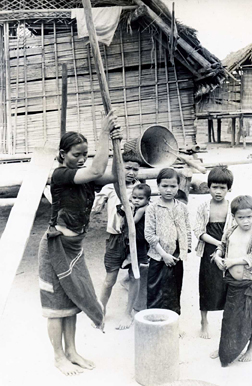 The narrator of Red Flags is warned not to smile too broadly at the Montagnards he meets – to them, our full Western teeth looked feral. Their standard of beauty required teeth to be chiseled down, sometimes into crude points, and lacquered black – or dyed black naturally by the frequent chewing of betel nut (a mild narcotic). I certainly remember the shock the first time a beautiful Montagnard woman smiled at me.
The narrator of Red Flags is warned not to smile too broadly at the Montagnards he meets – to them, our full Western teeth looked feral. Their standard of beauty required teeth to be chiseled down, sometimes into crude points, and lacquered black – or dyed black naturally by the frequent chewing of betel nut (a mild narcotic). I certainly remember the shock the first time a beautiful Montagnard woman smiled at me.
 Montagnard women did all the farming and all the heavy lifting, but they also owned everything, including the men. A groom went for about two dollars and a couple of water buffalo. The husband entered his wife’s clan, took his bride’s name and moved into her family’s longhouse. Their kids belonged to her clan; she arranged their marriages. Men had no power; her clan made all the big decisions. His role was to service her relatives. He hunted small game, trapped exotic birds or monkeys. If they divorced, she kept everything.
Montagnard women did all the farming and all the heavy lifting, but they also owned everything, including the men. A groom went for about two dollars and a couple of water buffalo. The husband entered his wife’s clan, took his bride’s name and moved into her family’s longhouse. Their kids belonged to her clan; she arranged their marriages. Men had no power; her clan made all the big decisions. His role was to service her relatives. He hunted small game, trapped exotic birds or monkeys. If they divorced, she kept everything.
As fit as they may look, most Montagnards suffered from half a dozen chronic tropical diseases. Treatments existed, but medical care for the tribespeople was close to non-existent. The Vietnamese, who despised the Montagnards, simply wouldn’t treat them, and Western doctors and nurses were few and far between. In the era in which Red Flags is set, Montagnard life expectancy hovered around forty. I doubt it’s any better today.